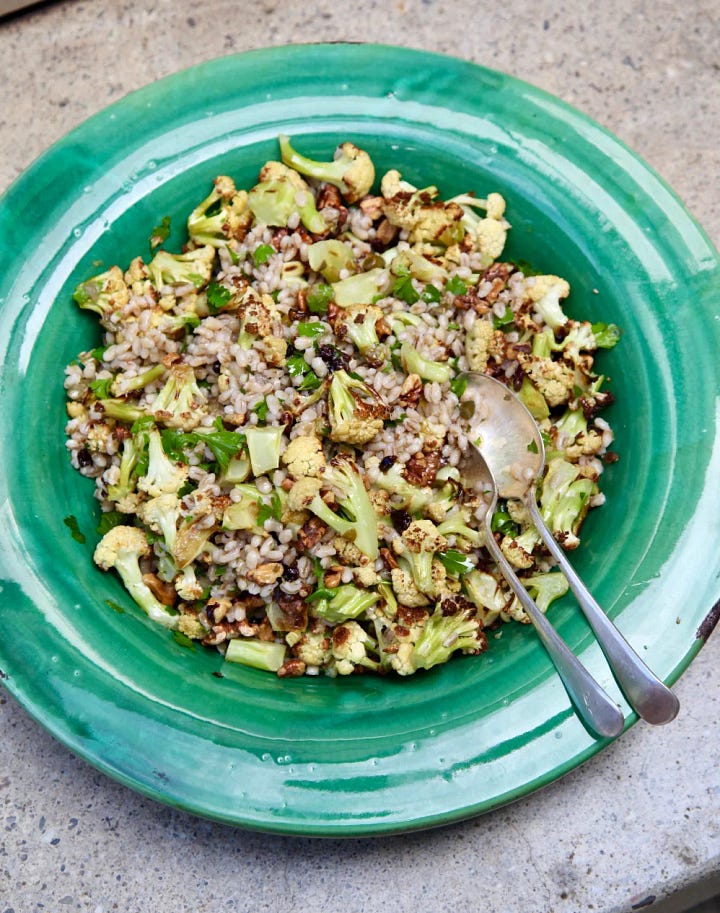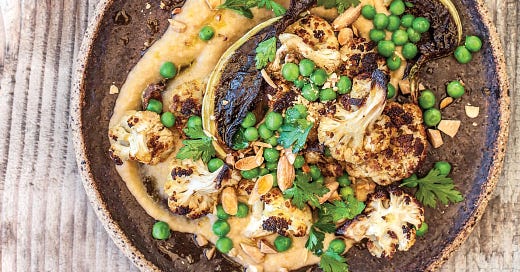In Season Right Now: Cauliflower
Easy recipes that make the most of this delicious vegetable in every which way — plus Annabel's gardening guide for spring!
With well-priced cauliflower available in NZ right now, we wanted to share some of our best-loved recipes that celebrate this fab vegetable. Cauliflower is such a versatile brassica, and one of our favourites — largely because of its adaptability, mild, slightly nutty flavour, and subtle earthiness. We love it roasted, raw, blanched, puréed, you name it.
This beautiful Roasted Cauliflower, Peas & Almonds is always a crowd-pleaser. Gorgeous enough to serve as a centrepiece at a dinner party, and easy enough for everyday eating, it’s such a useful recipe to have up your sleeve. Pair it with our beloved Grain Salad for a vegetarian Middle Eastern Feast.
It’s hard to beat a Crispy-Topped Cauliflower Cheese and a fresh Everyday Green Salad for a cozy dinner or weekend lunch. Pair it with a crisp white wine or a glass of bubbles and you have a special occasion menu! There is something so comforting about serving a homely meal with an elegant salad.
Another old favourite is this Roasted Cauliflower & Blue Cheese Soup. Roasted hazelnuts and crispy bacon make the most wonderful garnish for this soup. You could use just hazelnuts, but the combination of both makes this soup really special.
Chermoula, a fabulous Moroccan spice mix, adds a lovely depth of flavour to a classic Tray Bake that is particularly good with cauliflower — those little florets soak up the aromatics so wonderfully, without overpowering the flavour.
This vibrant Herbed Cauliflower Couscous is wonderfully light and flavourful thanks to an abundance of fresh crunchy vegetables, lots of aromatic herbs, and a creamy yoghurt dressing. If you don’t have a food processor, you can grate the cauliflower to a fine crumb consistency.


For our paid subscribers, you may like to revisit this satisfying Sicilian Cauliflower Salad — perfect for potlucks, picnics, and workday lunches, as it will keep in a covered container in the fridge for 4–5 days.
Our Crispy Rice Tabbouleh with Cauliflower & Kale is one of those things that will keep you going back for seconds, in the best way possible. Nutty toasted rice, fresh cauliflower and kale, bright herbs, crunchy cucumber, juicy sweet pomegranate, and tangy sumac onions come together so perfectly in this vibrant yummy recipe.
We also can’t get enough of these easy Spiced Cauliflower Tacos, you’ll have a speedy and delicious dinner on the table in 30 minutes!
Spring Gardening with Annabel
Now that we're past the spring equinox and the soil is warming up, it’s time to start thinking about your summer vegetable garden!
Growing your own vegetables is a satisfying (and delicious way) to cut back on your food costs. If you can plan ahead and grow from seed, it makes it even more economical.
Seeds and plants germinate and grow at different temperatures, so it's important to know what their tolerance is before you start to plant them. Seeds will germinate across a wide range of temperatures but as the temperature falls below the optimum range the length of time it takes for them to germinate increases and the percentage germination rate falls. Long germination times also makes the seeds more vulnerable to disease. One of the most useful things you can invest in is a soil thermometer. The air temp could be twenty degrees but the soil might still only be 8ºC and not many things will happily germinate at this low temperature.
Once the soil reaches 10°C, you can plant bok choy, broad beans, broccoli, kale, leeks, peas, radishes, spinach, spring onions, strawberries, and turnips.
Artichokes and asparagus tolerate the cold too but you won’t get a crop in your first season — you will need to wait until autumn or the following spring to get your first artichoke harvest and it’s a three-year wait before you can pick asparagus!
When the soil reaches 12°C, you can start planting beetroot, cabbage, carrots, cauliflowers, celery, fennel, all the lettuces, rocket, soft salad greens, and silverbeet. Labour weekend in late October is usually the cue to plant out seedlings of tender summer crops such as basil, beans, chillies, cucumbers, eggplants, potatoes, pumpkins, tomatoes, peppers, and zucchini. These need ground temperatures of over 15°C to survive and thrive (chillies, eggplants, cucumbers, and peppers actually like it to be at least 18°C which in places like Wānaka with cold night temps means they often do best in a greenhouse). Any chance of frost will see them curl up and die. But you can get them started earlier by germinating seeds in trays or pots indoors, so they’re ready to transplant when the soil warms up.
Seedlings usually need to be about six to eight weeks old before they are ready to be planted out. There are few things more frustrating than finding that everything is going to be ready to pick right at the time when you’re away on summer holidays, so it’s essential to consider how long it takes from planting a seed or seedling until harvest.
When considering planting-to-harvest timings, remember that different species take differing amounts of time from germination to harvest and hotter weather makes for quicker growth. Bok choy, radishes, and rocket are the speediest — you will have something to pick in 30 to 40 days. Parsnips, which take 150 to 300 days, operate at the other end of the spectrum. Garlic takes roughly six months — it goes into the ground on the shortest day (although in Wānaka I either plant in late May before the ground freezes, or wait until August before the ground unfreezes) and comes out on the longest.
In colder areas, anything that dislikes frosts has to be able to mature in the growing season between spring and autumn frosts. So even though beans take 65 to 100 days, if you leave it too late in the season to get them into the ground there isn’t enough time for them to mature before the days get too short and temperatures drop. That means that early January is fine to get a late crop of beans in but mid-February just won’t cut the mustard.
Coriander and spinach like it cool so spring and autumn are the best times for planting these — as the days lengthen towards summer they will bolt and form seeds. Any crop that has sat happily in the ground over winter growing ever so slowly will suddenly go to seed as soon as the days start to get longer, prompted by the increasing hours of daylight.
If you are growing from seed, check out the days-until-harvest information on the seed packet and work backwards from when you want to harvest to find out when to sow them. If buying seedlings at the garden centre, check the maturity details on the tags and time your purchases and plantings accordingly. As soon as one crop has been harvested you can get the ground ready to plant the next. If you are planning to head away at Christmas, I recommend doing a big plant before you leave so that when you come back in late January there are lots of vegetables coming into harvest rather than being at the end of their cycle.
Happy gardening everybody!
Let me know if you have any questions — you can comment below or reach out at hello@langbein.com.
With love,
Annabel & Rose xxx







Not a food related question but what is the significance of your logo?